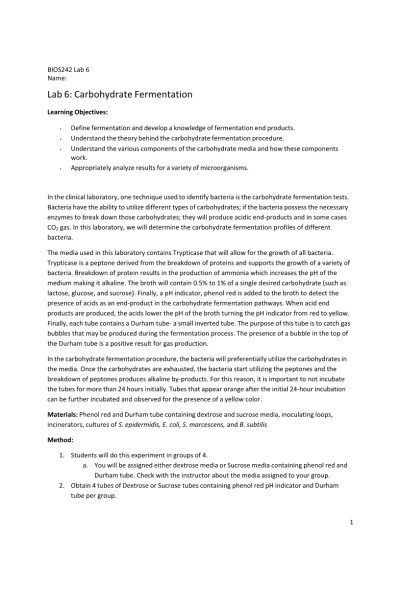BIOS 242 Week 3 Assignment; Lab 6 of 14 Onsite; Carbohydrate Fermentation
-
$20.00
| Institution | Chamberlain |
| Contributor | Nikki |
Document Preview
Lab 6: Carbohydrate Fermentation
Learning Objectives:
- Define fermentation and develop a knowledge of fermentation end products.
- Understand the theory behind the carbohydrate fermentation procedure.
- Understand the various components of the carbohydrate media and how these components
work.
- Appropriately analyze results for a variety of microorganisms.
In the clinical laboratory, one technique used to identify bacteria is the carbohydrate fermentation tests. Bacteria have the ability to utilize different types of carbohydrates; if the bacteria possess the necessary enzymes to break down those carbohydrates; they will produce acidic end-products and in some cases CO2 gas. In this laboratory, we will determine the carbohydrate fermentation profiles of different bacteria.
The media used in this laboratory contains Trypticase that will allow for the growth of all bacteria. Trypticase is a peptone derived from the breakdown of proteins and supports the growth of a variety of bacteria. Breakdown of protein results in the production of ammonia which increases the pH of the medium making it alkaline. The broth will contain 0.5% to 1% of a single desired carbohydrate (such as lactose, glucose, and sucrose). Finally, a pH indicator, phenol red is added to the broth to detect the presence of acids as an end-product in the carbohydrate fermentation pathways. When acid end products are produced, the acids lower the pH of the broth turning the pH indicator from red to yellow. Finally, each tube contains a Durham tube- a small inverted tube. The purpose of this tube is to catch gas bubbles that may be produced during the fermentation process. The presence of a bubble in the top of the Durham tube is a positive result for gas production.
In the carbohydrate fermentation procedure, the bacteria will preferentially utilize the carbohydrates in the media. Once the carbohydrates are exhausted, the bacteria start utilizing the peptones and the breakdown of peptones produces alkaline by-products. For this reason, it is important to not incubate the tubes for more than 24 hours initially. Tubes that appear orange after the initial 24-hour incubation can be further incubated and observed for the presence of a yellow color.
Materials: Phenol red and Durham tube containing dextrose and sucrose media, inoculating loops, incinerators, cultures of S. epidermidis, E. coli, S. marcescens, and B. subtilis
Method:
- Students will do this experiment in groups of 4.
- You will be assigned either dextrose media or Sucrose media containing phenol red and Durham tube. Check with the instructor about the media assigned to your group.
- Obtain 4 tubes of Dextrose or Sucrose tubes containing phenol red pH indicator and Durham tube per group.
- Label each tube with each of the bacteria listed in the materials section.
- Inoculate each tube with the appropriate bacteria using aseptic techniques.
- Incubate each tube at 37 ◦C for 18-24 hours.
- Keep the tubes closed and make observations using closed tubes only.
- Read and record your observations in the lab report.
- Get results from other groups in your class for the other media and record the observations in the lab report and complete the report.
- In the table in the Results section, “A” represents acidic end-products, “+” represents gas formation, and “-“ represents no change.
Lab Report:
Purpose: Please describe in complete sentences and in your own words, the purpose of this experiment.
The purpose of this experiment was to be able to use a technique that is used to identify bacteria through a fermentation test. Different carbohydrates are used, after inoculation we incubate the test tubes. This is meant to tell us whether the bacteria has the enzymes to break down the carbohydrates, if it does then the products will be acidic.……….. Continue
| Instituition / Term | |
| Term | Summer |
| Institution | Chamberlain |
| Contributor | Nikki |






























































































